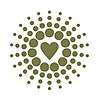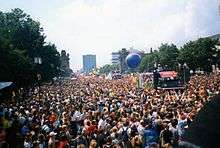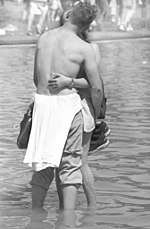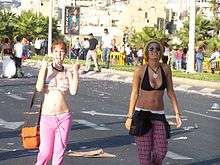Love Parade
The Love Parade (German: Loveparade) was a popular electronic dance music festival and technoparade that originated in 1989 in West Berlin, Germany.[1] It was held annually in Berlin from 1989 to 2003 and in 2006, then from 2007 to 2010 in the Ruhr region. Events scheduled for 2004 and 2005 in Berlin and for 2009 in Bochum were canceled.
| Love Parade Loveparade | |
|---|---|
 | |
 Loveparade 1998 in Berlin | |
| Genre | Electronic dance music festival and technoparade |
| Location(s) | Various locations in Germany |
| Years active | 1989–2003; 2006–2008; 2010 |
| Founded | July 1989 West Berlin, Germany |
| Most recent | 24 July 2010 |
On 24 July 2010, a crowd crush at the Love Parade caused the death of 21 people, with at least 500 others injured.[2] As a consequence, the organizer of the festival announced that no further Love Parades would be held and that the festival was permanently canceled.[3][4][5]
History

The parade first occurred in July 1989, when 150 people took to the streets in Berlin.[1] It was started by the Berlin underground at the initiative of Matthias Roeingh (also known as "Dr Motte") and his then girlfriend Danielle de Picciotto.[1] It was conceived as a political demonstration for peace and international understanding through love and music.[1] It was supposed to be a bigger birthday party for Roeingh, and the motto Friede, Freude, Eierkuchen (in English — Peace, Joy, Pancakes) stood for disarmament (peace), music (joy) and a fair food production/distribution (pancakes). Roeingh dissociated himself from the parade in 2006 because of the commercialization of the event.
The parade was held on the Berlin Kurfürstendamm until 1996. Because of overcrowding on this street, the festival moved to the Straße des 17. Juni in the Großer Tiergarten park in the center of Berlin. The festival became centered around the Siegessäule in the middle of the park; and the golden angel atop the column became the parade's emblem.
Many people from Germany and abroad traveled to Berlin to take part in the Parade — over a million attended in the years 1997 through 2000 and 800,000 in 2001. Attendance at the 2001 festival was significantly lower because the date of the parade was changed with little advance notice. 2002 and 2003 also saw lower figures, and in 2004 and 2005 the parade was canceled because of funding difficulties. The parade had inspired opposition because of the damage to the Tiergarten by attendees, who were provided with insufficient toilet facilities. Opponents allegedly complicated matters for organisers by booking their own events in Berlin and so to exclude the parade from being able to register with city police. In 2004, however, a scaled-down version took place which served more as a mini-protest and was promoted with the title Love Weekend. Dozens of clubs promoted the weekend-long event all over the city, with various clubs staying open for three days straight without closing. In 2006, the parade made a comeback with the help of German exercise studio McFit.
The Love Parade 2007 was planned for 7 July 2007 in Berlin. However, the Berlin event was canceled in February because the Senate of Berlin did not issue the necessary permits at that time. After negotiations with several German cities, on 21 July, it was announced that the parade would move to the Ruhr Area for the next five years. The first event took place in Essen on 25 August. The parade in Essen saw 1.2 million visitors in comparison to the 500,000 who attended the 2006 parade in Berlin.
In 2008, the festival took place in Dortmund on 19 July on the Bundesstraße 1 under the motto Highway of Love. The event was planned as a "Love Weekend", with parties throughout the region. For the first time the Turkish electronic scene was represented by its own float, called "Turkish Delights". The official estimate is that 1.6 million visitors attended, making it the largest parade to date.[6]
The 2009 event, planned for Bochum, was canceled;[7] a year later, the deaths of 21 attendees at the Duisburg venue prompted the parade's organiser Rainer Schaller to declare an end to the festival. "The Love Parade has always been a peaceful party, but it will forever be overshadowed by the accident, so out of respect for the victims the Love Parade will never take place again," Schaller said.[8] The parade was one of the oldest and largest festivals of electronic music, together with Zürich's Streetparade, Mayday and Nature One.
Setup
The music played at the events was predominantly electronic dance music — in this case mainly trance, house, techno, and schranz music. Attempts to introduce other music styles, such as hip hop, have failed. Hardcore and gabber music were part of the parade in early years, but were later removed. They are now celebrated separately on a counter-demonstration called "Fuckparade".
The parade was seen to be louder and more crowded than most concerts. With its water-cooled sound systems on every truck, the parade produced an extremely loud sound floor. After the 2001 arrangement, veterinarians at the Berlin Zoo blamed the parade for giving more than half of its animals diarrhea. Chairman Heiner Kloes said veterinarians told him the heavy bass was to blame for disturbing the animals.[9] The parade consisted of the sound trucks that usually featured local, or important, clubs and their DJs. It had become a rule that only trucks that had sponsors from a techno-related field, such as clubs, labels or stores, were allowed, but advertising space was increased after the 2006 event to offset the high costs of equipping a truck. The trucks were usually open on top and featured dancers, with box-systems mounted on the side or rear.
The parade was a place where some exhibited and enjoyed other people's exhibitionist tendencies.[1] Some attendees enjoyed carrying around toys such or other items such as dummies (pacifiers) or face masks. Often the crowd was imaginative in terms of clothing (or lack thereof) and appearance.
One famous picture from the parade is people sitting and dancing on streetlamps, trees, commercial signs, telephone booths, which gave the event's nickname "the greatest amateur circus on earth".[10]
The demonstration concluded with the so-called "Abschlusskundgebung" which were sets of the world's leading top DJs such as DJ Tiesto, Paul Van Dyk, Carl Cox, Armin Van Buuren, DJ Rush, DJ Hell, Westbam, Drum Connection, Miss Djax, Marusha or Chris Liebing. During this time all trucks (usually about 40) were connected to each other and set online to the statue of victory where the turntables are. This was one of the few chances a DJ can ever have to play for a crowd of about one million people.
Disturbances
The parade was quite peaceful for an event of its size, seeing few arrests. In 2008, for example, charges were pressed for six robberies, three sexually related offences and forty thefts. Twenty-three attendees were caught with drugs and forty-nine were charged with bodily harm. There were 177 parade visitors provisionally arrested by the police.[11] Arrests were usually related to drug crimes and most other incidents featured people passing out due to dehydration or hyperthermia. In 2000, after the parade, a girl under the influence of ecstasy was run over by an S-Bahn after she had been leaning on the door too hard.
2010 accident
At the 2010 Love Parade in Duisburg, the number of people attending allegedly reached 1.4 million – the original expectation was around 800,000 – whereas police believed around 400,000 people were present.[12] 21 people were killed, and more than 500 injured, in an incident on an overcrowded ramp leading from a tunnel into the festival. At least 20 casualties resulted from suffocation, caused by crowd pressure.[13]
Safety experts and a fire service investigator had previously warned that the site was not suitable for the numbers expected to attend.[8] Rainer Schaller, the festival's organizer and chief executive officer, later said the festival would not continue in future.
A preliminary investigation of the ministry of the interior placed heavy blame on the organizers around Rainer Schaller. Schaller in turn claimed that errors by the police in controlling streams of visitors led to the accident.[14]
Love Parade International
Similar festivals have taken place in other cities of Germany and many other countries worldwide. Large spin-off festivals in Europe include Zürich's Street Parade, Geneva's Lake Parade, Paris's Techno Parade, Rotterdam's FFWD Dance Parade, Munich's Union Move, Hamburg's Generation Move, Hannover's Reincarnation, Bremen's Vision Parade and the Love Parade and the Freeparade in Vienna. In 1994, 1995 and 1996 an event called Love Parade was held in Melbourne, Australia. Unlike its overseas counterparts, this was a smaller "rave party" version of the festival. In 1996 it was held at Festival Hall in West Melbourne and included a parade that made the evening news. It was followed in 1997 by a Love Parade in Sydney, Australia, likewise a smaller rave party, held at the infamous Graffiti Hall of Fame in Redfern. In 1999 and 2000 technoparades named "Buenos Aires Energy Parade" took place in Buenos Aires, Argentina under the motto "Love, Peace and Dance". On Saturday 8 July 2000 a Love Parade was held in Roundhay Park, Leeds, United Kingdom sponsored by BBC Radio 1. In 2001, the official UK parade had moved to Newcastle upon Tyne which was to have seen a parade through the streets of Newcastle before ending up on Town Moor but was canceled after the police refused a license: BBC Radio 1 still hosted a more contained event, however.[15] Since then no Love Parade has taken place in the United Kingdom. In Summer 2000 one of the first public events that took place in post-war Sarajevo, Bosnia and Herzegovina, was Futura, Festival of Electronic Music. Some of the world's most famous DJs, including the organizers of the Berlin Love Parade, performed in a bombed and burnt out factory.

After being held in the North-American Continent for the first time in Mexico (2002), in the fall of 2004 the Love Parade was held in San Francisco. They had held their inaugural Parade in September 2004 with 37,000 attending. The parade was held again in San Francisco in September 2005 as a rousing success drawing over 50–60,000 people. In 2006, the parade was held on 23 September and was renamed Love Fest because the Loveparade Berlin organization did not renew any of their worldwide licenses not already under contract so they could focus on their own event. 2009 was the biggest success of the parade now renamed Lovevolution with over 100,000 people. The first Love Parade in Santiago was held in 2005 and gathered over 100,000 people; the 2006 version gathered over 200,000 people. The first Love Parade in Caracas was held in June 2007 and gathered over 25,000 people.
Spin-off festivals of the Love Parade have taken place in:
- Berlin, Hamburg, Munich, Frankfurt, Bremen and Hannover, Germany
- Zürich, Geneva, Basel and Bern, Switzerland
- Vienna and Salzburg, Austria
- Paris, France
- Rotterdam, Netherlands
- Bologna and Turin, Italy
- Oporto, Portugal
- Sydney, Australia
- Buenos Aires, Argentina
- Rio de Janeiro, Brazil
- Santiago, Chile
- Leeds, England
- Budapest, Hungary
- Tel Aviv, Israel
- Mexico City and Acapulco, Mexico
- Oslo, Norway
- Cape Town, South Africa
- Caracas, Venezuela
- Little Rock, Arkansas; and San Francisco, California, United States
- Sarajevo, Bosnia and Herzegovina
Legal issues
Under German law the state has to pay for security during political demonstrations as well as cleaning up the streets after the demonstration.[1] In the case of a commercial event however, the organizer must cover these expenses. For a large event like the Love Parade the costs are quite high: an estimated €300,000 to €400,000.[1]
The Love Parade was initially held as a political demonstration to save costs; however it was organized by two companies set up just for the Love Parade.[1] Due to this there was a dispute between the organizers and the city of Berlin every year about the status of the Love Parade and who should bear what costs.[1] Finally in 2001, the courts ruled that the Love Parade had to be held as commercial event.[16]
Anthems
Every German parade has had its own anthem.
| Year | Artist | Title |
|---|---|---|
| 1997 | Dr. Motte and WestBam | Sunshine |
| 1998 | Dr. Motte and WestBam | One World One Future |
| 1999 | Dr. Motte and WestBam | Music Is the Key |
| 2000 | Dr. Motte and WestBam | One World One Loveparade |
| 2001 | The Love Committee | You Can't Stop Us |
| 2002 | The Love Committee | Access Peace |
| 2003 | The Love Committee | Love Rules |
| 2006 | WestBam & the Love Committee | United States of Love |
| 2007 | WestBam & the Love Committee | Love Is Everywhere (New Location) |
| 2008 | WestBam & the Love Committee | Highway to Love |
| 2010 | Anthony Rother | The Art of Love |
List of Love Parades
| Year | Location | Motto | Attendees |
|---|---|---|---|
| 1989 | Berlin | Friede, Freude, Eierkuchen (Eng.) Peace, Joy, Pancakes[1] |
150 |
| 1990 | Berlin | The Future Is Ours[1] | 2,000 |
| 1991 | Berlin | My House Is Your House And Your House Is Mine[1] | 6,000 |
| 1992 | Berlin | The Spirit Makes You Move[1] | 15,000 |
| 1993 | Berlin | The Worldwide Party People Weekend[1] | 31,000 |
| 1994 | Berlin | Love 2 Love[1] | 110,000 |
| 1995 | Berlin | Peace on Earth[1] | 280,000 |
| 1996 | Berlin | We Are One Family[1] | 750,000 |
| 1997 | Berlin | Let the Sunshine In Your Heart[1] | 1,000,000 |
| 1997 | Sydney | ||
| 1998 | Berlin | One World One Future | 800,000 |
| 1999 | Berlin | Music Is The Key | 1,500,000 |
| 1999 | Buenos Aires | (Buenos Aires Energy Parade) Amor, Paz y Dance parte 1 (Love, Peace and Dance part one) | 450,000 |
| 2000 | Berlin | One World One Loveparade | 1,300,000 |
| 2000 | Leeds | Radio One & Trade – One Love [17] | 500,000 [17] |
| 2000 | Buenos Aires | (Buenos Aires Energy Parade) Amor, Paz y Dance parte 2 (Love, Peace and Dance part two) | 750,000 |
| 2001 | Berlin | Join The Love Republic | 800,000 |
| 2001 | Newcastle upon Tyne (canceled) | ||
| 2002 | Berlin | Access Peace | 750,000 |
| 2002 | Mexico City | ||
| 2003 | Berlin | Love Rules | 750,000 |
| 2004 | San Francisco | ||
| 2005 | San Francisco | ||
| 2005 | Santiago | Sal a la calle y baila (eng. Get out there and dance) | 100,000 |
| 2006 | Berlin | The Love is Back | 1,200,000 |
| 2006 | San Francisco (as LoveFest) | ||
| 2006 | Santiago | El Baile es de Todos | 200,000 |
| 2007 | Essen | Love is everywhere | 1,200,000 |
| 2007 | Caracas | Live the Love! | 80,000 |
| 2007 | San Francisco | as LoveFest | 89,000 |
| 2008 | Dortmund | Highway to love | 1,600,000 |
| 2008 | Rotterdam | Olympic Edition | 500,000 |
| 2008 | San Francisco | as LoveFest[18] | 120,000 |
| 2008 | Caracas | Keep the Love Alive! | |
| 2009 | Bochum (canceled) | ||
| 2009 | San Francisco | as LovEvolution[19] | 150,000 |
| 2010 | Duisburg | The Art of Love | 1,400,000 |
According to media reports, the attendance figures had been forged by the organizers for years.[20][21] Accurate counts are not available since entry is free and uncontrolled. The mayor of Dortmund and the police confirmed the number of attendees in Dortmund.[22][23][24]
See also
- List of technoparades
- List of electronic music festivals
- Fuckparade
- Love Parade disaster
References
- John Borneman & Stefan Senders, "Politics without a Head: Is the "Love Parade" a New Form of Political Identification?" Cultural Anthropology J5(2) 294-31, American Anthropological Association. 2000
- "Love Parade report blames organisers for stampede – ABC News (Australian Broadcasting Corporation)". Abc.net.au. Archived from the original on 31 July 2010. Retrieved 28 July 2010.
- Staff writer (25 July 2010). "Organisers Blamed for German Love Parade Deaths — Survivors of a Stampede at a Free Dance Music Festival in Germany in which 19 People Were Killed Have Blamed Organisers for the Deaths". BBC News. Archived from the original on 25 July 2010. Retrieved 25 July 2010.
- Mara, Darren; Levitz, David (25 July 2010)."Prosecutors Launch Investigation into Love Parade Tragedy — German State Prosecutors Have Opened an Investigation into the Stampede that Killed 19 People and Injured Hundreds at the Love Parade Music Festival in Duisburg — But Questions Remain as to What Caused the Tragedy" Archived 28 July 2010 at the Wayback Machine. The Associated Press and Agence France-Presse (via Deutsche Welle). Retrieved 27 July 2010.
- Staff writer (25 July 2010). "No More Love Parades, Organiser Says — The Love Parade Will Never Be Held Again, Organiser Rainer Schaller Said on Sunday at a Highly-Emotional Press Conference". The Local. Archived from the original on 28 July 2010. Retrieved 27 July 2010.
- Volmerich, Oliver (21 July 2008). "Feucht, fröhlich, friedlich". Ruhr Nachrichten, Dortmunder Zeitung. pp. DOLO1x1., in German language
- "Loveparade 2009 Fällt Komplett Aus". Westdeutscher Rundfunk (WDR) (in German). 15 January 2009. Archived from the original on 18 January 2009. Retrieved 16 January 2009.
- Connolly, Kate (25 July 2010). "Prosecutors Investigate 'Ignored' Safety Warnings after 21 Die in Love Parade Crush — Organisers Allowed Just One Entrance to Music Festival Grounds for Expected Crowd of 1.4 Million, Witnesses Say" Archived 8 March 2016 at the Wayback Machine. The Guardian. Retrieved 27 July 2010.
- "Noiseletter - Spring 2003, Page 8". www.quiet.org. Archived from the original on 5 July 2008. Retrieved 28 July 2010.
- "At least 10 people killed, 15 injured at Love Parade in Germany - media (Update 1)". Sputnik International. 24 July 2010. Archived from the original on 27 July 2010. Retrieved 19 November 2012.
- Anon (21 July 2008). "Friedliche Party". Ruhr Nachrichten, Loveparade 2008 Dortmund. pp. LPDO1., in German
- "No Resignations, Just Unanswered Questions". Spiegel Online. 27 July 2010. Archived from the original on 27 July 2010. Retrieved 28 July 2010.
- Diehl, Jörg; et al. (28 July 2010). "The Facts Behind the Duisberg Disaster". Spiegel Online. Archived from the original on 23 March 2017. Retrieved 24 January 2018.
- "Jetzt 21 Tote durch Loveparade-Katastrophe – Deutschland & Welt – Rhein-Zeitung". Rhein-zeitung.de. Retrieved 28 July 2010.
- "Tyne – Love Parade". BBC. Archived from the original on 16 October 2015. Retrieved 28 July 2010.
- Florian Mayer, "Origins, Commodification, and Significance of Berlin's Love Parade" GRIN Verlag, 2007. ISBN 978-3638815796
- Lowe, Adam. "Laurence Malice: 12 Trade stories". 8 October 2014. Vada Magazine UK. Archived from the original on 2 April 2015. Retrieved 9 March 2015.
- "Lovevolution - A Dance Music Parade And Festival". Sflovefest.org. 12 July 2012. Archived from the original on 2 September 2006. Retrieved 26 March 2013.
- "Lovevolution - A Dance Music Parade And Festival". Sflovevolution.org. 12 July 2012. Archived from the original on 16 June 2009. Retrieved 26 March 2013.
- David Schraven: Teilnehmer-Zahlen zur Loveparade waren gefälscht, online portal Der Westen, 29. July 2010
- "Loveparade-Katastrophe – Trauer, Wut und Rücktrittsforderungen". sueddeutsche.de. 30 July 2010. Retrieved 12 February 2015.
- Staff writer (21 July 2008). "Loveparade Bricht Besucherrekord" (in German). loveparade.dortmund.de. Archived from the original on 27 July 2010. Retrieved 27 July 2010.
- Staff writer (n.d.). "1,6 Mio. Menschen Feiern in Dortmund" (in German). loveparade.dortmund.de. Archived from the original on 27 July 2010. Retrieved 27 July 2010.
- Staff writer (19 July 2008). "Loveparade in Dortmund — Raver-Rekord im Ruhrgebiet". Tagesschau (in German). Archived from the original on 1 July 2009. Retrieved 27 July 2010.
External links
| Wikimedia Commons has media related to Love Parade. |
- Love Parade 2008 in Dortmund – Official Site
- Berlin Life: 'The Death of Dance?' A history of the Berlin Love Parade
- San Francisco Love Fest (formerly Love Parade San Francisco)
- 2005 Lovefest Gallery
- Festivalpigs Love Parade and Euro Techno & Trance Festivals info
- Sean Nye and Ronald Hitzler. The Love Parade: European Techno, The EDM Festival, and The Tragedy in Duisburg
- Love Parade Argentina (Buenos Aires Energy Parade)